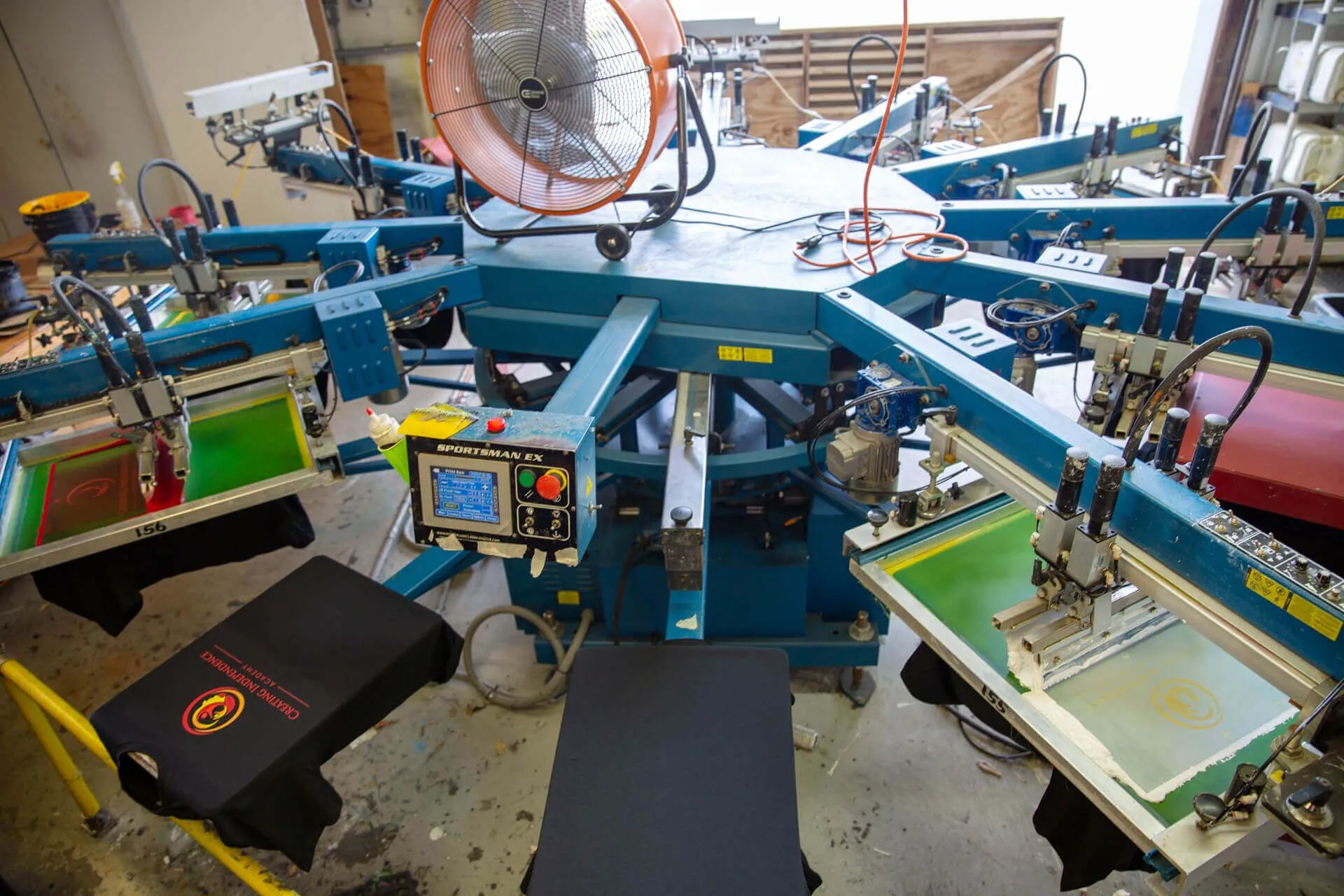Budget-Friendly T-Shirt Printing for Startups
Wiki Article
Display Printing Uncovered: Everything You Required to Know Regarding T-Shirt and Garment Printing Techniques
Screen printing is a remarkable method that integrates art with technique, supplying countless opportunities for imagination. Ready to explore the essential aspects that make screen publishing an art type?
The Fundamentals of Screen Printing: Exactly How It Works
When you dive right into screen printing, you'll find it's both an art and a scientific research. At its core, screen printing involves developing a pattern, or display, that enables ink to pass via only in specific areas.Next, you'll blend your inks and prepare your printing surface. Setting the display over the textile, then use a squeegee to push ink with the display onto the garment. This procedure calls for accuracy, as you want clear, vibrant prints. After printing, you'll treat the ink with heat, ensuring it follows the textile and lasts with cleans. Each step is necessary, and understanding them will raise your screen printing abilities, changing straightforward garments right into unique, expressive pieces.
Kinds Of Display Printing Methods
When you realize the basics of display printing, it's time to discover the various techniques that can raise your styles. One prominent approach is conventional display printing, where ink is pushed via a stenciled screen.If you're intending for fine information, take into consideration discharge printing. This technique eliminates color from the fabric, leaving a soft, vintage look. Another choice is plastisol printing, known for its sturdiness and dazzling shades, making it a favorite for lots of brands. Finally, experiment with halftone printing to create gradient impacts and detailed styles. Each method has its distinct charm, so do not be reluctant to try them out to find what matches your style best!
Essential Equipment for Display Printing
To achieve sensational cause screen printing, having the best equipment is essential. First, you'll require a sturdy display printing frame, which holds the mesh that transfers your layout onto the garment. Next off, purchase high-quality squeegees; these are important for applying ink equally across the display. You'll also call for a great direct exposure unit to produce your displays, along with a washout cubicle for cleaning them after usage. A reputable warm resource, like a conveyor dryer or warm press, is vital for treating your prints to assure durability. Don't fail to remember an appropriate office, geared up with tables and storage for your supplies. Finally, safety gear, such as masks and gloves, will maintain you safe from chemicals and inks. With the right devices, you'll be well on your way to generating professional-quality prints.Picking the Right Inks and Materials
When selecting inks and products for display printing, you require to think about the kind of ink that works finest for your project. Consider textile compatibility to guarantee your layouts look fantastic and last lengthy. Explore environment-friendly ink options to make your printing procedure extra lasting.Sorts Of Screen Inks
Choosing the appropriate screen ink is crucial for achieving vibrant, sturdy prints that meet your project's demands. There are a number of types of display inks to analyze. Specialized inks, such as glow-in-the-dark or metal, can include distinct impacts to your designs.
Fabric Compatibility Factors To Consider
Comprehending fabric compatibility is vital for achieving top notch display prints, particularly considering that different materials respond distinctly to various inks. When choosing inks, consider the material type-- cotton, polyester, or blends. For cotton, water-based inks function well, supplying soft qualities and breathability. Polyester, on the other hand, commonly calls for plastisol inks for far better attachment and lively colors. You may need to use a combination of both types if you're publishing on blends. Always test your inks on sample fabric to guarantee they adhere correctly and keep shade integrity. Furthermore, maintain in mind that fabric weight and structure can influence the last end result, so selecting the appropriate ink and product combination is crucial for your job's success.Eco-Friendly Ink Options
Green inks are coming to be a popular selection for screen printers that want to reduce their ecological impact while maintaining top quality. When choosing inks, take into consideration water-based inks, which are much less hazardous and much easier to clean up compared to standard solvents.Additionally, search for inks made from sustainable sources, such as soy or vegetable-based options. By selecting the ideal inks and products, you'll not just create stunning styles but likewise add to a much more lasting printing process. Make the switch, and your prints will certainly show your dedication to the environment!
Preparing Your Layout for Screen Printing

Submit Format Requirements
To ensure your style looks vivid and sharp on fabric, you'll need to pay close interest to file style demands for display printing. Begin with vector documents like AI or EPS, as they can be scaled without losing quality. If you utilize raster images, choose high-resolution data, such as TIFF or PNG, preferably at 300 DPI. Stay clear of making use of JPEGs, as they can shed clearness when resized. Make sure your design has a clear background to stop unwanted white sides on your prints. Finally, keep shade modes in mind; CMYK is typical for screen printing, so convert your RGB develops as necessary. By following these standards, you'll establish your art work up for an effective print.Color Splitting Up Strategies
Shade separation is an essential action in preparing your layout for display printing, and understanding it can greatly improve your print high quality. You'll require to break your layout right into specific shades, as each shade needs a different display during printing. Begin by identifying all the colors in your style and create layers for each one. You can make use of software application like Adobe Photoshop or Illustrator to separate and separate shades properly. Be certain to conserve each layer as a separate documents, usually in a format like TIFF or PSD. This accuracy not only ensures exact shade depiction yet also streamlines the printing procedure. By taking notice of shade splitting up, you'll attain vivid and expert outcomes in your screen-printed garments.Resolution and Dimension
Achieving the very best cause display printing starts with guaranteeing your design has the best resolution and dimension. Preferably, your art work ought to go to the very least 300 DPI (dots per inch) for sharp, clear prints. Your final product may look amateur and pixelated. if you use lower resolution.When it concerns dimension, consider the dimensions of your print location. Layout your artwork to match the final print dimension, preferably developing it in the actual measurements you'll be publishing. This means, you'll prevent any kind of unexpected scaling problems.
Constantly examine your design in both vector and raster layouts. Vector graphics can be scaled without losing high quality, making them suitable for display printing. Preparing properly will assure your layout looks fantastic on every garment!
Step-by-Step Display Printing Refine
Display printing is a vibrant process that enables you to develop dynamic layouts on numerous surface areas. To get begun, you'll require a screen, emulsion, and your picked ink. Initially, prepare your screen by cleaning it extensively. Next off, use the solution equally and allow it dry in a dark area. As soon as completely dry, expose your display to light with your design put on it, which will solidify the solution where the light hits, creating a stencil - screen printing kit.Pour ink onto the display and use a squeegee to push the ink through the pattern onto the fabric. Lift the display thoroughly and let the print dry. You have actually successfully display printed your layout.
Tips for Effective Display Printing Projects
While you're diving right into your display printing tasks, remember that preparation is key to success. Start by gathering all your materials-- inks, garments, mops, and screens. A tidy work area assists prevent unwanted errors, so clean before you start.Next, validate your art work is high-resolution and correctly sized for your garment. Evaluate your display for appropriate exposure and tidy it thoroughly to prevent spots. When mixing your inks, follow the maker's standards to achieve the best consistency.
During printing, use even pressure with your squeegee for constant outcomes. Do not hurry; take your time to validate each print satisfies your criteria. After printing, let your garments completely dry completely prior to taking care of or packaging them.
Lastly, always keep a sample of your benefit future reference. In this manner, you can examine your progress and boost your strategies with time. Satisfied printing!

Regularly Asked Inquiries
The length of time Does It Take to Establish a Display Printing Job?
Establishing up a screen printing work generally takes around 30 minutes to an hour. You'll prepare the displays, mix inks, and change journalism. The time differs based upon complexity and experience, garment printing so stay organized!Can I Publish on Different Textile Types Using the Exact Same Strategy?
Yes, you can print on different material types utilizing the exact same technique, yet you'll need to adjust your setups and inks. Some fabrics take in ink in different ways, so exploring assurances the most effective outcomes for each product.What Are Typical Mistakes to Avoid in Display Printing?
When screen printing, stay clear of typical mistakes like making use of the wrong ink, overlooking proper direct exposure times, or skipping pre-press checks. Constantly examine your configuration and maintain clean screens to guarantee quality outcomes each time.Just How Can I Effectively Tidy and Keep My Display Printing Tools?
To effectively tidy and keep your screen printing devices, you need to regularly wash screens with proper solvents, inspect squeegees for wear, and assure all tools are stored completely dry and dust-free. Consistency avoids costly repairs and enhances performance.Is Display Printing Eco-friendly Contrasted to Various Other Approaches?
Screen printing can be a lot more eco-friendly than other techniques, particularly if you utilize water-based inks and eco-conscious products. By picking lasting supplies and practices, you minimize waste and decrease your impact on the world.Display Printing Uncovered: Everything You Need to Know About Tee Shirt and Garment Printing Techniques
At its core, screen printing includes creating a stencil, or display, that permits ink to pass through only in details areas. Placement the screen over the material, after that utilize a squeegee to press ink through the display onto the garment. One popular method is traditional screen printing, where ink is pushed via a stenciled display.When choosing inks and materials for screen printing, you need to take into account the type of ink that works finest for your job.
Report this wiki page